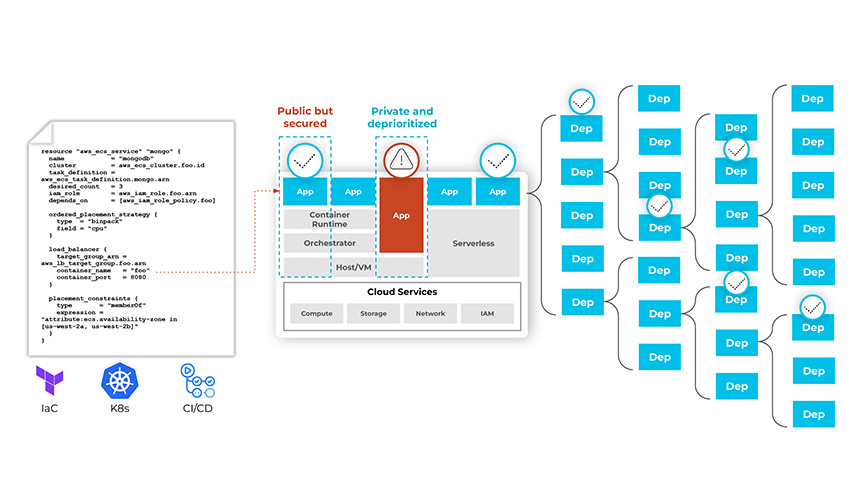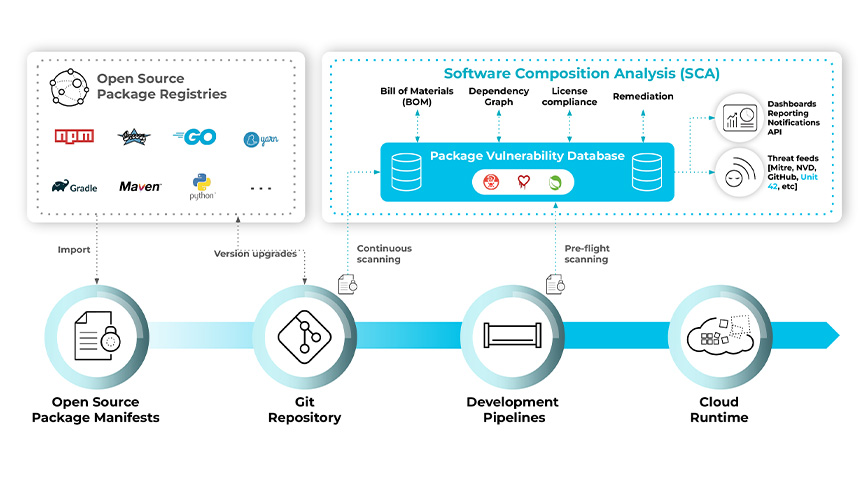- What Is Application Security Posture Management (ASPM)?
- How DSPM Is Evolving: Key Trends to Watch
- Interactive Application Testing & ASPM: Closing DevSec Gaps
- Buy or Build: Calculating ASPM ROI for Your Organization
- Overcoming AppSec Chaos: 7 Modes of ASPM Adoption
- ASPM: The Evolution Beyond ASOC
- Top Cloud Data Security Solutions
- Selecting Your ASPM Solution: Metrics That Matter
- ASPM in Action: 8 Real‑World Use Cases
-
State of ASPM 2025: Key Trends & Emerging Threats
- ASPM Market Evolution and Adoption Trajectory
- AI-Native ASPM and Machine Learning Integration
- Cloud-Native Security Challenges and Container Orchestration Threats
- Software Supply Chain Vulnerabilities and SBOM Evolution
- DevSecOps Integration and Future ASPM Architecture
- ASPM Key Trends & Threats FAQs
-
Application Security Best Practices You Can’t Skip in ASPM
- ASPM Architecture: From Tool Sprawl to Unified Intelligence
- Advanced Risk Correlation and Contextual Prioritization Systems
- Policy-Driven Security Automation and Enforcement Architecture
- Seamless DevOps Integration and Cloud-Native Security Orchestration
- Enterprise Scalability, Performance Engineering, and Compliance Automation
- Application Security In ASPM Best Practices FAQs
-
How Supply Chain Threats Are Shaping ASPM Today
- The Supply Chain Attack Surface in Modern ASPM
- Critical Supply Chain Vectors Driving ASPM Evolution
- Software Supply Chain Risk Assessment and Prioritization
- Architectural Shifts in ASPM for Supply Chain Defense
- Operationalizing Supply Chain Security Within ASPM Programs
- Supply Chain Threats Are Shaping ASPM FAQs
-
How ASPM Strengthens Your Cloud Ecosystem
- ASPM's Role in Unified Cloud Security Architecture
- Integration Points Across the Cloud Security Stack
- Risk Intelligence and Contextual Prioritization in Cloud Environments
- Operational Efficiency Through Automated Cloud Security Workflows
- Strategic Advantages for Cloud-First Organizations
- ASPM Strengthening the Entire Cloud Ecosystem FAQs
-
Developer Infrastructure Posture: Integrating ASPM Early
- Understanding Developer Infrastructure Posture
- ASPM Fundamentals: Beyond Traditional Application Security
- Early Integration Strategies: Embedding ASPM in Developer Workflows
- ASPM Compliance Framework Integration
- Risk Prioritization and Remediation at Scale
- Developer Infrastructure Posture Management and ASPM FAQs
- Amplify ASPM with RBVM Risk‑Based Vulnerability Management
- CNAPP and ASPM Collaboration, Not Collision
- CSPM Vs ASPM: Where Your Focus Belongs
-
Why You Need Static Analysis, Dynamic Analysis, and Machine Learning?
-
What Is a Software Bill of Materials (SBOM)?
- Software Bill of Materials Explained
- Who Should Have a SBOM
- The Role of SBOMs in Cybersecurity and Compliance
- Why Is an SBOM Important?
- Software Composition Analysis and SBOMs
- How Does an SBOM Help Prevent Open-Source Supply Chain Attacks
- SBOM Formats
- Software Bill of Materials Best Practices
- SBOM FAQs
- What Is Policy-as-Code?
- What Is Static Application Security Testing (SAST)?
- What Is Code Security?
- What is Infrastructure-as-Code Security
- What is IaC?
- What Is Secrets Management?
- What Is Infrastructure as Code (IaC) Supply Chain Security?
- ASPM Tools: Evaluation Criteria and How to Select the Best Option
What Is Software Composition Analysis (SCA)?
Software composition analysis (SCA) provides a deep analysis of open source packages in use by an application. SCA highlights vulnerabilities and licenses in dependencies for risk and compliance assessments, and it can generate a software bill of materials (SBOM) of all resources to share with internal stakeholders and external customers.
What Is Software Composition Analysis?
Software composition analysis safely enables developers to leverage open source packages without exposing organizations to unnecessary vulnerabilities or legal and compliance issues.
Open source components have become pervasive in modern software development, with the majority of modern applications’ codebases made up of such packages. This method allows developers to move more quickly since they don't need to recreate code that is freely available and vetted by the community. However, this process also comes with its own set of risks.
What Are the Risks of Using Open Source Components?
Before building container images with these components, developers need to be aware of security concerns stemming from previously discovered vulnerabilities in the packages. They also need to ensure they are meeting compliance requirements around software use licenses.
Community members frequently find and patch vulnerabilities, but the burden is on developers to update their code. When a vulnerability is found, it’s only a matter of time before a public exploit is made available, opening the door for even low-level attackers to take advantage of the issue.
The problem is exacerbated by the fact that a majority of vulnerabilities in software are not in immediate or root packages but in dependencies of dependencies, multiple layers deep. Fixing just the root packages in use will not always secure the libraries in use.
Additionally, there are dozens of open source licenses with a variety of rules. For example, some require attribution while others require the source code for the application that uses the component to also be published. Keeping track of all of the licenses and their rules can be difficult.
Software Composition Analysis Identifies Risks in Open Source Packages
SCA tools identify all open source packages in an application and all the known vulnerabilities of those packages. This knowledge can be used to notify developers of the issues in their code to fix them before they are exploited. A good software composition analysis process will look beyond package managers into infrastructure as code (IaC) and Kubernetes manifests, pulling images to identify vulnerabilities in those images. 
SCA tools with connections to IaC templates and limitless dependency scanning ensure vulnerabilities don’t go undetected or unresolved.
Software composition analysis tools can also be used to generate a software bill of materials (SBOM or software BOM) that includes all the open source components used by an application. The SBOM lists details about the package version as well as known vulnerabilities and licenses for each component in use. For example, for Python, the BOM will include all the packages in import statements, such as httplib2, along with the version number, discovered vulnerabilities and licenses for each package.
SCA programs should enable collaboration among stakeholders such as engineering, DevOps, security and compliance teams. Many organizations will use these programs to create alerts and/or block code from merging into repositories if said code includes open source components that violate the organization’s compliance mandates for controlling exposure. Determining an acceptable severity level for vulnerabilities and license types should involve the relevant stakeholders.
How to Use SCA in the Development Processes
A good SCA process is embedded throughout the development process. Starting in local environments, developers need to be able to check their code for vulnerabilities and license compliance as they write it.
Leveraging integrated development environments (IDEs) plugins, SCA tools can notify developers about vulnerabilities as they add packages. Before code is committed to a repository, checks and automated pull request comments should inform developers of any issues being introduced and block code that does not meet requirements.
This should carry over to deployments where software with predetermined levels of vulnerabilities or types of licenses can be blocked from being deployed. Security teams should also have broad visibility into the posture of the components in their environment.

Software composition analysis extends coverage from code to cloud and from infrastructure to application layers to track vulnerabilities throughout the development lifecycle.
In all areas, developers should be informed about risks to which the packages can expose them. Vulnerabilities need to be ranked and prioritized (e.g., using CVE scores and time since the vulnerability was reported) based on criticality and infrastructure impacts (e.g., if the vulnerable package is in a private VPC). Licenses should be grouped by those allowable but that require additional details, such as attribution, and those that are not allowable under organization policies, such as "copyleft" licenses.
The Benefits of Software Composition Analysis
It is important for teams to be aware of the posture of their application environments. By providing license compliance and vulnerability feedback early and often, software composition analysis helps alleviate some of the risks of using open source components in applications. While 100% patch rates are unlikely, knowing the risk and weighing the cost to fix a vulnerability is part of improving security posture.
To learn more about securing modern development processes, check out What Is DevSecOps?